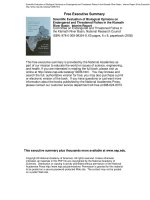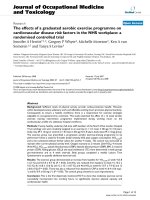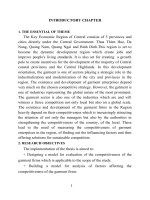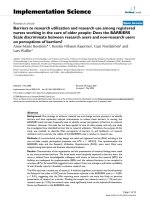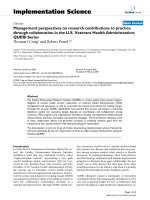RESEARCH ON COMPETITIVENESS OF GARMENT FIRMS IN THE KEY ECONOMIC ZONE OF CENTRAL
Bạn đang xem bản rút gọn của tài liệu. Xem và tải ngay bản đầy đủ của tài liệu tại đây (406.64 KB, 27 trang )
MINISTRY OF EDUCATION AND TRAINING
UNIVERSITY OF DA NANG
----------------------
VO THI QUYNH NGA
RESEARCH ON COMPETITIVENESS
OF GARMENT FIRMS IN THE KEY ECONOMIC
ZONE OF CENTRAL
MAJOR: INDUSTRIAL ECONOMY
CODE: 62.31.09.01
SUMMARY OF PH.D THESIS ON ECONOMICS
Danang - 2014
1
THESIS IS DONE AT
University of Economics, University of Da Nang
Thesis advisors: Assoc. Prof. Dr. Nguyen Truong Son
Doan Gia Dung, Ph.D.
Reviewer 1: Prof. Dr. Hoang Ngoc Viet
Reviewer 2: Assoc. Prof. Dr. Tran Van Hoa
Reviewer 3: Do Thi Thanh Vinh, Ph.D.
The thesis was presented before the Thesis Commitee at the
University of Da Nang on March, 1st 2014
Thesis can be found at:
2
INTRODUCTORY CHAPTER
1. THE ESSENTIAL OF THEME
The Key Economic Region of Central consists of 5 provinces and
cities directly under the Central Government: Thua Thien Hue, Da
Nang, Quang Nam, Quang Ngai and Binh Dinh.This region is set to
become the dynamic development region which create jobs and
improve people's living standards. It is also set for creating a growth
pole to create incentives for the development of the majority of Central
coastal provinces and the Central Highlands. In this development
orientation, the garment is one of sectors playing a strategic role in the
industrialization and modernization of the city and provinces in the
region. The existence and development of garment enterprises depend
very much on the chosen competitive strategy. However, the garment is
one of industries representing the global nature of the most prominent.
The garment sector is also one of the industries which are and will
witness a fierce competition not only local but also on a global scale.
The existence and development of the garment firms in the Region
heavily depend on their competitiveness which is increasingly attracting
the attention of not only the managers but also by the authorities in
strengthening the competitiveness of the country, of the local. These
lead to the need of measuring the competitiveness of garment
enterprises in the region, of finding out the influencing factors and then
offering solutions for sustainable competition.
2. RESEARCH OBJECTIVES
The implementation of the thesis is aimed to:
+ Designing a model for evaluation of the competitiveness of the
garment firms which is applicable to the scope of the study.
+ Building a model for analysis of factors affecting the
competitiveness of the garment firms
1
+
Identifying
the
current
and
predictable
status
of
the
competitiveness of garment enterprises in the region when compared
with each other and with garment firms outside of the region.
+ Verifying the influence of factors, both inside and outside of the
firm, to the competitiveness of the garment firrms of the Key Economic
Region of Central.
+ Suggesting a system of appropriate solutions to maintain and
improve competitiveness for these garment frms.
3. OBJECTS AND SCOPE OF THE STUDY
+ Research objects: competitiveness of garment enterprises
+ Scope of Research:
Regarding content: evaluate the competitiveness of garment firms in
The Key Economic Zone of Central; analyze explanatory factors of
garment firms competitiveness and propose a system of solutions to
maintenance and improve the competitiveness of garment enterprises in
The Key Economic Zone of Central.
Regarding the research object: the sewing businesses whose
products are mainly clothing (industry code is 14100).
On the spatial scale: the headquarters of the garment firms are in The
Key Economic Zone of Central. In term of market, the spatial scale will
cover both domestic and foreign markets.
About time range: As usual, the 2012 data will not be available
before August 2013, so data range handled is only until 2011.
4. RESEARCH METHODS
The thesis is done in mixed methods: combining qualitative and
quantitative.
+ Qualitative Method: Theoretical background research and
interviews with experts
2
+ Quantitative Methods: descriptive statistics, index, ANOVA on Excel
5. EXPECTED RESULTS
The thesis is expected to achieve the following results:
+ A relatively completed theoretical background of competitiveness
+ A evaluation model and a explanatory model of garment firms
competitiveness of enterprises which are applicable in a specific research
context: the Key Economic Region of Central.
+ Assessment results of competitiveness of garment firms in the Key
Economic Region of Central.
+ Analysis findings of influences of factors on the competitiveness of
the garment firms of the Key Economic Region of Central.
+ A number of proposals at the micro level and macro level in order to
improve the competitiveness of garment firms of the Key Economic
Region Central
6. OVERVIEW OF RESEARCH
+ The levels of competitiveness rechearchs
+ The points on competitiveness research
+ The main research directions of competitiveness
+ The main research directions of competitiveness in the garment
industry
+ Theoretical background has been applied in the studies of the
garment industry competitiveness
+ The research methods and results
3
CHAPTER 1
THEORETICAL AND PRACTICAL BACKGROUND OF
ESTABLISHING MODELS FOR STUDYING
COMPETITIVENESS OF GARMENT FIRMS
1.1. FIRM COMPETITIVENESS
1.1.1. The concepts of firm competitiveness
In this section, many competitiveness concepts are introduced. These
are concepts which are often cited, referenced in a lot of
competitiveness researches works, including the concept of the report
on the oversea trade activities in some branch of Loyds (1985), of
D'Cruz and Rugman (1992), of Markusen (1992), of the European
Community Europe (1993), of the White Paper on competitiveness of
the UK (1994 ), of Chickan (2001), of the Asian Development Outlook
(2003), of Vu Trong Lam (2006).
1.1.2. Characteristics of competitiveness
In addition to the multi-level attribute of competitiveness concept,
this concept has also additional connotation such as multi-defined,
multi-measured, dependent, relative and dynamic.
1.1.3. The concept of firm competitiveness of the thesis
With a Performance viewpoint, inheriting the spirit of the precede
research on competitiveness, in this thesis, competitiveness is the ability
of firms in dealing with competition to maintain and enhance the value
of the firm.
1.2. MODELS FOR STUDYING FIRM COMPETITIVENESS
1.2.1. An overview of the competitiveness research models
+ In term of level of competitiveness: there are models for studying
national competitiveness, industrial competitiveness and corporational
competitiveness.
4
+ In terms of research focus: there are models for competitiveness
evaluation, for analysis of factors affecting competitiveness.
Taking into account the scope of the research topic, only reaearch
models of corporational competitiveness are presented.
1.2.2. Research models of firm competitiveness
The models are sorted into three groups:
+ Group of competitiveness evaluation models includes the Three
Dimensions of Competitiveness, the Total Value Competitiveness, the
Economic Value Added, the Value Curve, the Balanced Score Card, the
Integrated Value Management, the Total Shareholder Returns, the Gelei
model.
+ Group of explanatory models includes the Diamond framework,
the Competitiveness Triangle
+ Group of integrated models includes EFQM model and APP
model
1.3. FORMATION
OF
MODELS
FOR
STUDYING
COMPETITIVENESS OF GARMENT FIRMS
1.3.1. An overview of the garment industry
+ The concept of the garment product, garment enterprise, the
garment industry
+ Some basic characteristics of garment industry
1.3.2. The basic considerations when designing research models of
competitiveness of garment firms
+ Taking into account the perspective of investors, of customers and
of employees about the value of the firm
+ Taking into account the scope of market and the influence of
location on competitiveness
5
+ Evaluation is not only focused on competitiveness in the past and
present but also directed to predictable competitiveness in the future.
+ Characteristics of the value chains within the enterprise and its
position in garment value chain of finished products that companies
involved are viewed as a set of factors affecting the competitiveness of
garment enterprises.
1.3.3. Preliminary
ideas
on
the
measuring
model
on
competitiveness of garment firms
1.3.3.1. Model for measuring competitiveness
From a given number of constraints, based on considerations
inherited from the previous models and results of experts interviews, the
model for measuring garment enterprises competitiveness will consist
of two components: competitive outcomes and competitive potentials.
COMPETITIVENESS OF GARMENT FIRMS
Competitive outcomes
Competitive potentials
Financial results
Internal process
performance
Customer satisfaction
Workers satisfaction
Figure 1: Model for measuring garment firm competitiveness
6
1.3.3.2. Explanatory model for competitiveness
The model is based on the Diamond model and then adjusted based
on the considerations presented in Section 1.3.2 and results of experts
interviews.
Firm factors
Accessibility of
major inputs
Demand
conditions
Garment firm
competitivenes
s
Accessibility of
major support
services
Government
support
Industrial
competition
characteristics
Hình 2: Explanatory factors of competitiveness of garment firms
1.4. DEPLOYMENT
OF
MODELS
FOR
STUDYING
COMPETITIVENESS OF GARMENT FIRMS
1.4.1. The
purpose
of
the
deployment
model
research
competitiveness of garment enterprises
+ Determining the competitiveness indicators that correspond to the
evaluation components including Competitive Outcomes and Copetitive
Potentials that can be applied to evaluating the competitiveness of
garment firms in research context: the Key Economic Region of Central.
+ Specifying the factors of 6 groups of factors in the adjusted
Diamond model which is supposed to have a real impact on the
7
competitiveness of garment firms
in research context: the Key
Economic Region of Central.
1.4.2. Research process for deploying the evaluation model and
the explanatory model of competitiveness of garment firms
Step 1: Determining implementation approach
Step 2: Review of researchs on competitiveness
Step 3: A preliminary survey
Step 4: A survey on data sources
Step 5: Review the competitiveness indicators and the factors that
affect competitiveness
1.4.3. The competitiveness indicators of garment firms
1.4.3.1. In case of comparison with only domestic rivals
Based on the suggestions of the foregoing researchers, on results
of expert interviews and of survey on data availability (presented in
Table 1.3 and 1.4 in the thesis), the selected indicators are:
+ Competitive Results will include indicators such as average
revenue growth, returns on equity (ROE), Value added per labor (VA /
L), market share and average labor income.
+ Competitive Potentials will include indicators such as
productivity, unit labor costs (ULC), rate of inventory and unit costs.
1.4.3.2. In case of comparison with foreign rivals
+ In the domestic market: in terms of competitiveness results,
competitiveness will be assessed through the domestic market share and
in terms of competitive potentials, competitiveness will be assessed
through ULC.
+ In the international market: competitiveness will be assessed
through international market share and ULC.
8
1.4.4. The factors affecting the competitiveness of the garment
firms
Based on the suggestions of the foregoing researchers, on
results of expert interviews and of survey on data availability (presented
in Table 1.5 and 1.6 in the thesis), the factors group are modified and
specified. The factors such as firm size, category of ownership and
region are viewed as the root factors affecting the competitiveness of
garment enterprises in the region. Since then, the hypotheses related to
the study of root factors are suggested.
Government
support
Demand
conditions
Firm
factors
Industrial
competition
characteristics
Region
Accessibility
support
services
Category
Accessibility
of major inputs
Size
Competitiveness of garment firms in the Key
Economic Region of Central
Figure 3: The adjusted explanatory model of competitiveness of
garment firms in the Key Economic Region of Central
Thus,
from
the
theoretical
models
for
studying
the
competitiveness of garment firms, combined with results of in-field
experts interviews, the models of measuring and of explaining
competitiveness of garment firms were adjusted to fit with the research
context and their application will be presented in the next chapter,
9
CHAPTER 2
FINDINGS OF RESEARCH ON COMPETITIVENESS OF
GARMENT FIRMS IN THE KEY ECONOMIC REGION OF
CENTRAL
2.1 OVERVIEW
2.1.1. An overview of garment firms in the Key Economic Region
of Central
2.1.1.1. Quantity and the structure
For the majority of the provinces and city in the Key Economic Region
of Central, garment industry is considered one of the key economic sectors.
Thus, in recent years, the number of garment firms is continuously
increasing. In 2011, the total number of garment firms which size from
small to big is 148, of which 108 small and medium–sized firms and 40
large-sized garment firms. A major of these firms are located in Danang
and Quang Nam.
If classified by categories of ownership, these garment firms have
distributed mainly in 4 groups of categories: private enterprise, joint stock
company , limited liability company and foreign direct investment firms.
2.1.1.2. Capital and labor of garment firms in the Key Economic
Region of Central
In 3 years, from 2009 to 2011, along with an increase in the number
of firms, number of employees and capital of garment firms in the
region is also expanded continuously
2.1.1.3. The key products and the key markets
The key products of the garment companies in the region include
shirts, jackets, trousers... Their important markets are the U.S., the EU,
Korea, Japan, South America, the domestic market.
2.1.2. An overview of the research on competitiveness of garment
firms in the Key Economic Region of Central
+ Due to limited availabity of data, only evaluation in comparison with
domestic rivals can realized with indicators mentioned in section 1.4.3
10
+ The modified Diamon model will be applied for analyzing
affecting factors and the influence of the root factors will be tested.
+ Approach in the evaluation is that the judgement will be based on
the mean of each firms groups, but taking into account individual
factors by using descriptive statistical methods. The influence of the
root factors will be tested through ANOVA in Excel
+ The data used in the evaluation of competitiveness and in the
factors analysis is processed from results of the annual enterprises
surveys realized by the General Statistics Office, and of additional
preliminary survey and of other sources.
2.2. MEASURING COMPETITIVENESS OF GARMENT FIRMS
(GROUPED BY SIZE) IN THE KEY ECONOMIC REGION OF CENTRAL
2.2.1. Measuring competitiveness of small-sized and mediumsized garment firms compared with large-sized garment firms in
the Key Economic Region of Central
The competitiveness of garment firms in the Region will be judged
on two aspects: the Competitive Outcomes and Competition Potentials,
while the influence of firm size on competitiveness will be tested.
2.2.1.1. Measuring competitiveness in terms of Competitive
Outcomes
Table 1: Summary of the competitiveness evaluation on
Competitive Outcomes of the two groups of garment firms in the
Key Economic Region of Central (grouped by size)
Chỉ tiêu
Revenue growth (%)
ROE (%)
VA/L (million dongs)
Market share (‰)
Labor income (million dongs)
Note:
SME
2010
Large
firms
Test
result
27,840
-5,320
16,179
0,033
17,403
-7,895
3,916
19,267
1,160
19,839
0
0
1
1
SME
2011
Large
firms
95,184 143,891
3,414 24,431
28,204
41,125
0,033
1,475
28,549 33,091
Test
result
1
1
1
1
Data sources by author's calculations from GSO.
SME: Small- and Medium-sized Enterprise
A.: Average
0: rejected
1: accepted
11
2.2.1.2. Measuring competitiveness in terms of Competitive
Potentials
Table 2: Summary of the competitiveness evaluation on
Competitive Potentials of the two groups of garment firms in the
Key Economic Region of Central (grouped by size)
Chỉ tiêu
2010
Large
firms
37,112 60,091
SME
Productivity (million dongs)
ULC (dong)
Rate of inventory (%)
Unit cost (dong)
1,317
12,326
2,711
2011
Large
firms
58,851
97,627
Test
result
0
SME
1,138
14,456
0
0
1,019
13,125
2,711
0
2,167
Test
result
1
0,821
17,034
0
0
2,148
0
(Data sources by author's calculations from GSO)
2.2.2. Assessing the competitiveness of small-sized and mediumsized garment firms in the Key Economic Region of Central
compared with same sized garment firms in the other key
economic regions
The competitiveness of garment firms in 3 Key Economic Regions
will still be judged on two aspects of Competitive Outcomes and
Competitive Potentials, and influence of location in a specifice region
on competitiveness will be tested.
Table 3: Summary of assessment of the competitiveness of smalland medium-sized garment firms in three Key Economic Regions
Chỉ tiêu
Central
Năm 2010
North Central
South
Test
Năm 2011
results
North 2010 2011
South
Revenue growth (%)
27,84
ROE (%)
-5,320
16,179
28,29
11,97 95,18
36,25
-23,970 -18,914 3,414 -41,662
29,893 23,311 28,204 47,651
-7,531
40,859
0,033
17,403
0,111
27,477
0,085 0,033
23,090 28,549
0,0741
38,731
VA/L (million dongs)
Market share (‰)
Labor income (million dongs)
Productivity (million dongs)
ULC (dong)
Rate of inventory (%)
Unit cost (dong)
37,122
1,313
12,326
2,711
68,12
0
0
1
1
1
1
1
1
120,841 86,988 58,211 167,773 160,858 1
1,307
1,035 1,019
1,234
1,304
0
18,564
19,147
13,125 16,630 18,483 1
5,459
5,060 2,167
4,342
4,725
0
1
0
0,079
41,387
(Data sources by author's calculations from GSO)
12
1
0
2.2.3. Assessing the competitiveness of large-sized garment firms
in the Key Economic Region of Central compared with same sized
garment firms in the other key economic regions
Table 4: Summary of assessment of the competitiveness of largesized garment firms in three Key Economic Regions
Chỉ tiêu
Trung bộ
Nam bộ Bắc bộ Trung bộ Nam bộ
Kquả
kđịnh
Bắc bộ 2010 2011
Revenue growth (%)
ROE (%)
VA/L (million dongs)
Market share (‰)
-7,895
3,916
19,267
1,160
19,839
19,94
7,075 143,891 55,59
-33,047 -29,237 24,431 11,727
30,077 29,617 41,125 51,537
1,685
1,305 1,475
1,358
31,450 25,745 33,091 48,790
68,007
30,724
50,777
1,142
41,447
0
1
0
1
0
0
0
1
82,492 62,357 97,627 131,215 110,329
1,023 1,137 0,821
1,291
1,191
11,622 11,423 17,034 14,476 12,393
2,659 4,394 2,148
3,009
2,359
1
0
0
0
0
0
0
0
Năm 2010
Labor income (million dongs)
Productivity (million dongs)
ULC (dong)
Rate of inventory (%)
Unit cost (dong)
60,091
1,138
14,456
2,711
Năm 2011
(Data sources by author's calculations from GSO)
2.2.4. Measuring the competitiveness of different categories of
garment enterprises in the Key Economic Zone of Central
In this section, garment firms are grouped by categories of
ownership. And 4 popular categories of garment firms are studied,
including private enterprises, joint stock companies, limited liability
companies
and foreign invested enterprises. In this case,
competitiveness is still evaluated in terms of Competitive Outcomes and
Competitive Potentials. The approach taken is based on descriptive
statistics and influence of category on competitiveness will be tested
through ANOVA analysis in Excel.
2.2.5. Measuring the competitiveness of private garment
enterprises in the Key Economic Region of Central compared with
garment firms of same category in other key economic regions.
In this section, the competitiveness of private garment enterprises in
the Key Economic Zone of Central was assessed in comparison with
13
garment enterprises of same category in the Key Economic Zones of
South and of North. Evaluation structure is similar to section 2.2.3.
2.2.6. Measuring competitiveness of garment joint-stock firms in
the Key Economic Regions of Central in comparison with other
firm of same type in other key economic regions.
This section is deployed in a similar manner to Section 2.2.5 with
objects submitted to measuring are garment joint stock companies.
2.2.7. Measuring competitiveness of limited liability garment
firms in the Key Economic Region of Central in comparison with
other firm of same type in other key economic regions
This section is deployed in a similar manner to Section 2.2.5 with
objects submitted to measuring are limited liability companies.
2.2.8. Measuring competitiveness of foreign-invested garment
firms in the Key Economic Region of Central in comparison with
other firm of same type in other key economic regions
This content is deployed in a similar manner to Section 2.2.5 with
objects submitted to evaluation are foreign-invested garment firms.
Summing up all the above assessments can draw some general
remarks are the following:
In term of comparison results:
+ Based on the mean of indicators, the large-scale garment
enterprises have greater competitiveness than small-sized and mediumsized garment firms. The difference in the competitiveness within each
group is quite clear.
+ In term of the mean of indicators, the joint stock garment
companies have the greatest competitiveness while superior in many
evaluation indicators in 2 years. The uneven in each group are quite
significant.
+ In term of the mean of indicators, the garment firms in the Key
Economic Region of Central have less competitiveness than garment
businesses of same category in the Key Economic Region of South and
14
of North, especially among foreign-invested garment firms and largescaled garment firms. But generally, competitiveness of garment firms
in the Key Economic Region of Central was improved in 2011.
In term of difference intra group:
+ There is an important difference between the companies in each
group.
+ This difference frequently appeared in group of small- and
medium-sized firms, group of private garment firms…Obviously,
competitiveness depends on the behavior of the enterprise rather than on
the explicit characteristics of firms.
In term of influence of root factors:
+ Size factor does not always affect the competitiveness of garment
firms
+ Region factor unevenly affects the competitiveness of the garment
firms, considering the size as well as indicators of competitiveness.
+ Firm category factor doesn’t has significantly influence on
competitiveness of the garment enterprises.
+ Region factors have uneven influence on competitiveness of
garment firms of different categories and in term of different indicators.
+ Region factors have the most revealed effect on competitiveness of
garment firms in terms of average labor income.
2.3. ANALYSIS OF FACTORS AFFECTING COMPETITIVENESS OF
GARMENT FIRMS IN THE KEY ECONOMIC REGION OF
CENTRAL
2.3.1. Firm Factors
2.3.1.1. Modes of garment manufacturing
Research data shows actual garment production methods more or
less affect the competitiveness of garment enterprises in the region. The
small- and medium-sized garment firms mainly applied the CMT and
OEM. While OEM proportion of large-sized firms is higher and there
are some companies upgrading to ODM and OBM methods. Thus, ROE
15
and VA/L of the later are both better than the former group. However,
the positive relationship between garment manufacturing methods and
competitiveness of garment enterprises doesn’t always existe.
2.3.1.2. Elaboration of business plans, strategies
The data shows that there is a certain relationship between the
planing and the competitiveness of garment enterprises in the region.
The large-scale garment enterprises are interested in long-term planning
than small- and medium-scaled enterprises and their competitiveness is
also better in many ways. However, the more important factor is the
quality of the strategic plan which can not be found out in the research.
2.3.1.3. The level of mechanization of the garment manufacturing
The level of mechanization of the local garment enterprises
limited at stage of fabric laying and trimming. In fact, the productivity
of companies in the region may be more limited than the garment
enterprises in different key economic regions.
2.3.1.4. Application of management systems
The application of the ISO system, WRAP, or SA, or OSHAS ... is
frequently found in large-scale and medium-scaled garment firms.
These companies represent the strength in exports to the large and
demanding markets such as the EU, U.S. and Japan ...
2.3.1.5. Workforce qualification of garment firms in the Key
Economic Region of Central
Actual data on labor skills of the garment firms in the Key Economic
Region of Central (2011-present at the level of qualifications of
workers) showed that while many indicators of competitiveness of
large-scaled garment firms are better than small- and medium-scaled
ones, their workforce qualification is unfortunately lower than the
small- and medium-scaled garment firms. This does not reflect the fact
that labor qualification has no impact on competitiveness. In fact, it
reflects the fact that other qualifications would not be out of the labor
quality indeed.
16
2.3.2. Accessibility of major inputs of garment firms in the Key
Economic Region of Central
2.3.2.1. Impact of accessibilty of human resources in the regiong
on competitiveness of garment firms in the region
In this section, there is data on human resources (of the 3 regions for
comparison), with the analysis of labor skills, the discipline of the
workforce in the region ...
2.3.2.2. Impact of accessibilty of capiatal on competitiveness of
garment firms in the region
In this section, there an analysis of the presence of the banking
system and the credit institutions in the region; policies of these
institutions; changes in interest rates associated with the capital
structues of garment firms in the region.
2.3.2.3. Impact of support and relating industries on
competitiveness of garment firms in the region
In this section, there is data about the support and relating industries
in Vietnam, particular in the Key Economic Region of Central;
qualitative assessment of explanatory factors for competitiveness of
garment firms in the region.
2.3.3. Accessibility of support services for garment firms
In this section, a relative relationship between the shortcomings of
industrial services, logistics services... and the competitive weaknessof
the garment firm in the region compared to the other major economic
regions, especially the Key Economic Region of South.
2.3.4. Industrial rivalry characteristics in the Key Economic
Region of Central
Garment firms in the region have an obvious advantage when setting
in a zone which have firm densities less than 2 other Key Economic
Regions. However, degree of similarity of products is higher and price
competition is more fierce. In terms of regions, garment firm with
specialty products have more competitiveness.
17
2.3.5. The support of government and business associations for
garment firms in the Key Economic Region of Central
The garment enterprises, especially of small and medium size, get
the attention of the authorities. Many localities in the region set target to
become a textile-garment centers.
2.3.6. Demand condition
Some changes in the size and behavior of a number of target
markets (both domestic and international) provide both challenges and
opportunities for garment firms.
CHAPTER 3
IMPLICATIONS
3.1. OPPORTUNITIES AND CHALLENGES FOR THE GARMENT
FIRMS IN THE KEY ECONOMIC REGION OF CENTRAL
3.1.1. Opportunities
In the future, the garment enterpises in the Key Economic Region
may receive more opportunities derived from the Development Plan of
Vietnam's textile and garment industry in 2015 with Vision 2020; from
the strong support of governments at all levels; from growth trends of a
number of key markets in the near future (2013-2015); from trend of
Vietnamese consumption of domestic apparel, and other opportunities.
3.1.2. Challenges
The garment enterprises in the Region will also face some
challenges, such as the appearance of a growing number of foreign
competitors, increasing requirements for product and parts origin when
exported to a number of key markets, counterfeit goods (for firms in
ODM and OBM methods), technical barriers in international markets...
18
3.2. STRENGTHS AND WEAKNESSES OF ARMENT FIRMS IN THE
KEY ECONOMIC REGION OF CENTRAL AND OF SOME MAIN
COMPETITORS
3.2.1. In the domestic market
In the domestic market, compared to the garment firms from China,
Korea, Japan, Hong Kong, Thailand, Italy, Indonesia that are the main
foreign competitors (imports worth more than 2 million USA in 2011UNCOMTRADE), the gament firms in the Region have many
weaknesses in terms of scale, quality, perceived value of the product,
design, diversity of product, ability to control a source of high quality
materials and sometimes in terms price. Obvious strengths of garment
enterprises in the region is low labor costs, near market and higher
cultural understanding. Compared with the garment enterprises in other
key economic regions, garment firms the Region may also have more
weaknesses.
3.2.2. In the international market
Compared to foreign competitors from China, Bangladesh, India,
Cambodia, Indonesia, Pakistan, Sri Lanka (since most are involved in
the form of CMT, the mining cost advantage and geographical
proximity), Turkey (the cost is not high and near the EU) and Mexico
(the cost is not high and near the U.S.) and the competitors in two other
key economic region, the comparison is still unfavorable for firms in
the Region because they lose the advantage of close distance to the
market.
19
3.3. SWOT ANALYSIS FOR GARMENT FIRMS IN THE KEY
ECONOMIC REGION OF CENTRAL
3.3.1. Opportunities (O)
O1. Becoming one of textile centers of the country
O2. The government's support
O3. The government incentives for small- and medium-scaled garment
firms
O4. The expansion of markets
O5. Increasing demand of domestic market
O6. The signing of the trade agreements
O7. Foreign investment flows into production of garment materials and
accessories
O8. The U.S. and EU importers' switch to suppliers outside China
O9. The development of Source ASEAN full service alliance
3.3.2. Threats (T)
T1. More and more competitors
T2. Stringent requirements on the origin of goods
T3. More and more of counterfeit goods, pirated goods
T4. Labor costs increased due to many reasons
T5. The emergence of technical barriers in the big markets
3.3.3. Strength (S)
S1. Labor is abundant
S2. Low labor costs
S3. Near by and understanding the local market
S4. Some companies have the relatively good management and
Marketing competences
3.3.4. Weaknesses (W)
W1. Unqualified labor skills and low labor discipline
W2. The technology level is not uniform
W3. Low design skill
W4. The product quality is unstable
W5. Perceived value of the brand is not high
20
W6. Many businesses also have limited capital
W7. Many enterprises have poor competence of management and of
Marketing
W8. Far from sources of good raw materials
PAIRS OF COMBINATIONS
S-O
1) S2 S3 - O5
2) S1 S2 - O4 O6 O8
3) S1 S2 S4 - O1 O9
W-O
1) W2 W 6 - O1 O2 O3
2) W8 - O7
3)W1 W2 W3 W - O1 O9
S-T
1) S1 S2 - T1
W-T
1) W8 - T2
2) W4 - T5
3.4. SOLUTIONS OF ENHANCING COMPETITIVENESS OF GARMENT
FIRMS IN THE KEY ECONOMIC REGION OF CENTRAL
3.4.1. Solutions at firm level
3.4.1.1. Diversifying markets and products
Based on the analysis of the market prospects, this solution indicates
some markets in which, garment firms in the region can exploit, as well
as some lines of specialty products can be developed corresponding to
each target market.
3.4.1.2. Selecting the suitable mode of garment manufacturing
This solution suggests a number of directions in the selection
garment manufacturing modes corresponding behavioral characteristics
of the buyers in the target market as well as the resources of the
company
3.4.1.3. Keeping in consolidating the cost advantage
21
This solution includes proposals to reduce costs, such as
identification and mitigation of activities which do not create value,
innovation of production methods and organization of garment
production, renovation of garment production equipment,
computerization of the operations, and improvement of labor
productivity
3.4.1.4. Increasing the perceived value of the products
This solution aims to increase the perceived value of the products of
garment enterprises in the region through intensive investment into
designing to provide truly unique and innovative designs; through
selection of valuable materials; through enhancing brand promotion
activities in specific activities such as fashion shows, participation in
industrial fairs…
3.4.1.5. Reducing lead time
Garment firms can shorten lead time through proactive early offers,
sharing orders, materials sources control right after offers, planing and
serious control of plan implementation...
3.4.1.6. Developing the ability to provide full service
Increasing ability to provide information on new materials, to
participate in design activities, to consult fashion trends, to undertake
logistic activities of input and output, quality control...
3.4.1.7. Some other solutions:
* Achieving certification agaisnt international standards to improve
the confidence of buyers
* Orientation towards environmental protection in production
3.4.2. The solutions at the macro level
3.4.2.1. Development of selective support industries
+ Industrial orientation: towards the industries not requiring
complicated technology, less environmental pollution (sewing, buttons,
lace ..)
+ Local orientation: not investing in the 5-scattered localities in the
region; not investing in the dyeing industry in Danang and Quang Nam
22
because of the risk of sea pollution; this industry can be invested in
Thua Thien Hue.
3.4.2.2. Strengthen state management and businesses support
functions
Strengthening the role of the authorities and of fuctional
management bodies in implementing government policy on small and
medium garment enterprises, human resource training in sewing, trade
promotion for garment industry , providing market information,
certification of origin, anti counterfeit ...
3.4.2.3. Enhancing intra-regional cooperation in the development
of the garment industry
The viewpoint is that provinces and city in the regiong exploit
together comparative advantage of localities in the region. Orientation
of intra-local cooperation: at the corporate level (sharing orders,
marketing collaboration, collaborative training ...) and at the local level
(discussion in the planning sector, collaboration in organinsing
industrial fairs, in promoting trade..)
CONCLUSION
With all the contents have been presented above, the thesis
achievements can be summarized as follows:
1. The results of the thesis
Compared with the objectives of the thesis, research project has
achieved the following results:
+ A relatively complete theoretical background of competitiveness,
including research perspective of competitiveness, the inner meaning of
the competitiveness concept; models for research of competitiveness at
the firm level of and theoretical background of apparel industry.
+ A distinctive theoretical model to assess competitiveness and
analyze the factors affecting the competitiveness of garment enterprises.
+ A model of competitiveness research (evaluation and factor
analysis) have applicability in the research context of the Key
23


